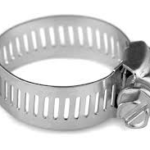Navigating the World of Stainless Steel Hose Clamps Stainless steel hose clamps are small but crucial components in various industries and DIY projects. Whether you're a professional in automotive, plumbing, or industrial sectors or just a curious individual, this article will give you insights into these essential tools. We'll cover the what, why, and how—ranging from types and applications to selection criteria and proper installation.
Types of Stainless Steel Hose Clamps
Exploring the primary types of hose clamps is essential for making informed decisions. While each type serves a specific purpose, they all aim to provide a secure connection.
Worm Gear Clamps
Worm gear clamps are ubiquitous and versatile. They feature a stainless steel band and a screw mechanism. The screw can be manipulated with simple tools like a screwdriver or socket wrench, enabling easy adjustments. These clamps can be utilized across diverse applications, making them a go-to option for many professionals.
T-Bolt Clamps
High-pressure applications often require the use of T-bolt clamps. Their T-shaped bolt provides a robust grip, making them a common choice in automotive and industrial environments. Engineered to withstand high pressures and vibrations, T-bolt clamps are suitable for heavy-duty uses.
Spring Clamps
Spring clamps offer an innovative design featuring a constant tension mechanism. Tool-free installation sets them apart from other types. Often used in automotive repairs for securing radiator hoses and vacuum lines, spring clamps are convenient for quick tasks.
Understanding the unique benefits of each type enables you to make an informed decision based on your specific needs.
Applications of Stainless Steel Hose Clamps
A broad array of industries rely on stainless steel hose clamps. Their ubiquity can be attributed to their reliability, durability, and versatility.
Automotive Industry
Within automotive sectors, these clamps have critical roles in coolant, fuel, and air intake systems. Offering secure, leak-free connections, they are essential for optimal vehicle performance. In any kind of vehicle, from family cars to commercial trucks, these clamps are indispensable.
Plumbing and HVAC Systems
In both residential and commercial settings, plumbing and HVAC systems use stainless steel hose clamps to establish secure pipe and duct connections. Ensuring a leak-free seal, these clamps contribute to energy-efficient and effective systems.
Industrial Applications
Manufacturing, construction, agriculture, and mining industries make extensive use of hose clamps. They ensure the smooth operation of diverse systems, such as hydraulic and pneumatic setups. Their corrosion and temperature resistance make them appropriate for harsh industrial settings.
Clearly, these clamps offer wide-ranging applications, with their versatility being a major contributing factor to their popularity.
Selecting the Right Stainless Steel Hose Clamps The right clamp for your project depends on several factors. Ignoring these could lead to less-than-optimal results.
Key Considerations for Clamp Selection
- Identify your application to understand which type of clamp—worm gear, T-bolt, or spring—is most appropriate.
- Evaluate operating conditions like temperature, pressure, and potential chemical exposure to determine the suitable clamp type.
Material Grades and Compatibility
It's crucial to note that these clamps come in various stainless steel grades like 304 and 316. Consider the material compatibility between the clamp and the hose or environment to ensure longevity.
Proper Sizing and Compatibility
Ensure you select a clamp size matching the hose diameter. Check the clamp's range, which represents its minimum and maximum diameters, to guarantee flexibility.
Quality Metrics to Keep in Mind
Invest in reputable brands backed by good reviews and ratings. Insist on high-quality stainless steel that offers corrosion resistance. Pay attention to design aspects like smooth edges, sturdy construction, and certified quality standards.
By following these guidelines, you can better ensure that your selected clamp will meet your project's specific demands.
Installation Guidelines
- Start by cleaning the hose surface to remove any debris or contaminants that could compromise the seal.
- Place the clamp around the hose, ensuring it's properly aligned.
- Use appropriate tools to tighten the clamp, but avoid overtightening as that could damage the hose.
Product Reviews and Comparisons
All Stainless Steel Hose Clamps Review
The All Stainless Steel Hose Clamps come fully packed with features designed for durability and performance. Sporting 300 Series Stainless Steel in the band, housing, and screw, these clamps are built for top-notch corrosion resistance. This makes them particularly useful for marine applications where exposure to salty air is a concern. The 1/2" band and 5/16" slotted hex head screw ensure a robust grip.
Stainless Steel Hose Clamps w/ Zinc Plated Screw Review
A slight step down in terms of all-around stainless steel construction, these clamps feature a 301 Series Stainless Steel band and a 201 Series Stainless Steel housing. However, they compensate for it with a zinc-plated 5/16" slotted hex head screw. While these clamps offer good performance, the zinc-plated screw might not provide the same level of corrosion resistance as the all-stainless model.
Wrapping Up
This in-depth look at stainless steel hose clamps leaves no stone unturned. From their types and usage across various industries to selection guidelines and maintenance tips, the aim has been to provide a comprehensive understanding of these unassuming yet pivotal components.
They might be small, but their impact is vast, enabling effective operations in automotive, plumbing, industrial settings, and beyond. If you're looking for a secure, reliable connection in any of these contexts, knowing what to look for in a stainless steel hose clamp will guide you towards a suitable solution.



